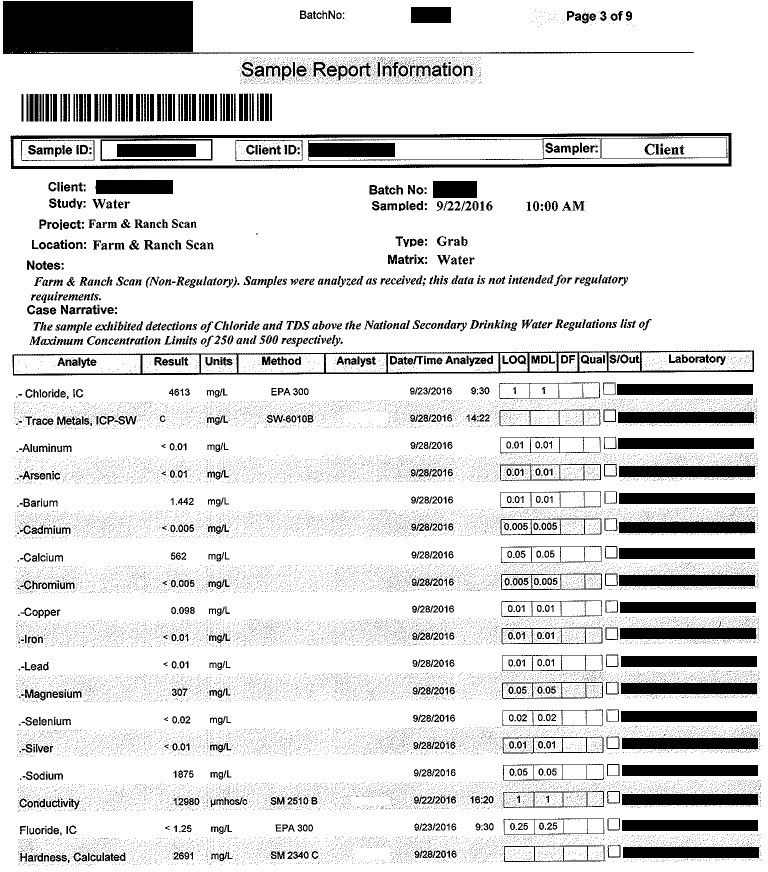
Lab Results Say How Much?
Let me start out right now by warning you this post is long and detailed with no pictures.
After ten long days of testing and a nine-page report, it was determined by the independent lab, our water was the worst of all waters. It took them nine pages to tell us what we already knew, our water problems were far from over. It took them nine pages to inform us our water contained 6359 mg/l of total dissolved solids. What does that mean exactly? Oh, that’s right, it took them nine pages to confirm our water was both hard and salty.
Let us not be too harsh, over 20 other elements were found within the sample. And hey, on the positive note, no harmful elements were found. There was no arsenic or lead or mercury. There was no chlorine or fluoride, both of which are found in city waters all across this great nation. So yeah, there was positive results on this nine-page report. It just wasn’t the results wanted.
According to www.water-research.net “dissolved solids” refer to any minerals, salts, metals, cations or anions dissolved in water. Total dissolved solids (TDS) comprise inorganic salts (principally calcium, magnesium, potassium, sodium, bicarbonates, chlorides, and sulfates) and some small amounts of organic matter that are dissolved in water.” The more TDS in the water, the less safe it is to drink.
What exactly is drinkable water? That is an answer without a simple, straight answer. As described by the EPA, primary drinking water regulations are “legally enforceable standards that apply to public water systems” and secondary drinking water regulations “are established only as guidelines to assist public water systems in managing their drinking water for aesthetic considerations, such as taste, color, and odor. These contaminants are not considered to present a risk to human health“. The EPA states “drinking water averages between 200 and 300 milligrams per liter total dissolved solids and water with TDS greater than 500 milligrams per liter is not recommended for human consumption.” Ah-hem, 500 mg/l of TDS. Ok then, as it turns out, the well water is just a little over the safe drinking range. It’s a good thing we don’t live in the dark ages.
Modern man has the ability to remove TDS resulting in drinkable water. Removing TDS from water is not new science. This has been done for years, hence the popularity with bottled waters, through a process known as the reverse osmosis (RO) system. In the RO system, water is passed through a membrane under pressure removing particles from the water. RO systems can be bought at the local home improvement stores and are small enough to fit under the average sink for drinking water or designed especially to meet special water needs large enough to handle full, top of the line cruise ship where thousands of gallons an hour are created from salt water. Systems, no matter the size, are both costly and wasteful. Costs can vary from a few hundred dollars a year, maintenance included, to hundreds of thousands of dollars where yearly maintenance still costs several thousand dollars more. For every gallon of RO water, one gallon of waste water is removed. RO systems are so effective in their duties, they remove all elements from the water leaving the water tasteless. Tasteless water is not only deeeee-sgusting to drink straight from the tap, it will also absorb the flavor of the container in which water is passed through and stored. Don’t get me wrong, water completely removed of all elements is used to brew tea and coffee, produces the best tasty drink! Tasty drinks are the least of our concerns right now. Boxes in Fields needs drinkable water, not the best water.
Lab results were sent to a RO specialist based out of Florida and just a few days later they called back with a price starting point. For water of our severity, a salt water RO system would cost $25K. This does not include shipping, installation or yearly maintenance costs between $1800-$2400. Yozers! To effectively filter our water through several membranes, the system required the use of a 800 psi pump. These systems are very common, produce 2000 gallons of water daily, and require regular usage to maintain effective filtration. Therefore, it is not possible to turn the system on once a month to fill a holding tank. In conclusion, not only is the system too costly, it produces more water than needed. Not in the market of wasting water to create water, obtaining affordable drinkable water is back to square one. No, wait, square three. Square one was city water, square two was well water. So yeah, square three.


